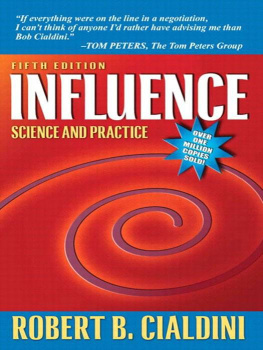Harvard Business Review - Influence and Persuasion
Here you can read online Harvard Business Review - Influence and Persuasion full text of the book (entire story) in english for free. Download pdf and epub, get meaning, cover and reviews about this ebook. year: 2017, publisher: Harvard Business Review Press, genre: Politics. Description of the work, (preface) as well as reviews are available. Best literature library LitArk.com created for fans of good reading and offers a wide selection of genres:
Romance novel
Science fiction
Adventure
Detective
Science
History
Home and family
Prose
Art
Politics
Computer
Non-fiction
Religion
Business
Children
Humor
Choose a favorite category and find really read worthwhile books. Enjoy immersion in the world of imagination, feel the emotions of the characters or learn something new for yourself, make an fascinating discovery.

- Book:Influence and Persuasion
- Author:
- Publisher:Harvard Business Review Press
- Genre:
- Year:2017
- Rating:4 / 5
- Favourites:Add to favourites
- Your mark:
Influence and Persuasion: summary, description and annotation
We offer to read an annotation, description, summary or preface (depends on what the author of the book "Influence and Persuasion" wrote himself). If you haven't found the necessary information about the book — write in the comments, we will try to find it.
Changing hearts is an important part of changing minds. Research shows that appealing to human emotion can help you make your case and build your authority as a leader.
This book highlights that research and shows you how to act on it, presenting both comprehensive frameworks for developing influence and small, simple tactics you can use to convince others every day.
This volume includes the work of:
- Nick Morgan
- Robert Cialdini
- Linda A. Hill
- Nancy Duarte
This collection of articles includes Understand the Four Components of Influence, by Nick Morgan; Harnessing the Science of Persuasion, by Robert Cialdini; Three Things Managers Should Be Doing Every Day, by Linda A. Hill and Kent Lineback; Learning Charisma, by John Antonakis, Marika Fenley, and Sue Liechti; To Win People Over, Speak to Their Wants and Needs, by Nancy Duarte; Storytelling That Moves People, an interview with Robert McKee by Bronwyn Fryer; The Surprising Persuasiveness of a Sticky Note, by Kevin Hogan; and When to Sell with Facts and Figures, and When to Appeal to Emotions, by Michael D. Harris.
How to be human at work.The HBR Emotional Intelligence Series features smart, essential reading on the human side of professional life from the pages of Harvard Business Review. Each book in the series offers proven research showing how our emotions impact our work lives, practical advice for managing difficult people and situations, and inspiring essays on what it means to tend to our emotional well-being at work. Uplifting and practical, these books describe the social skills that are critical for ambitious professionals to master.
Harvard Business Review: author's other books
Who wrote Influence and Persuasion? Find out the surname, the name of the author of the book and a list of all author's works by series.


















